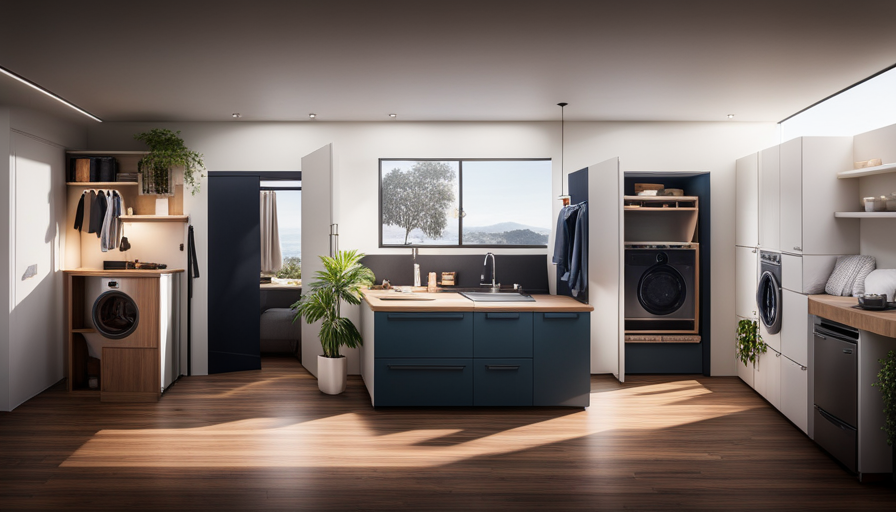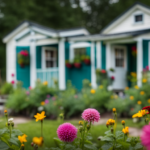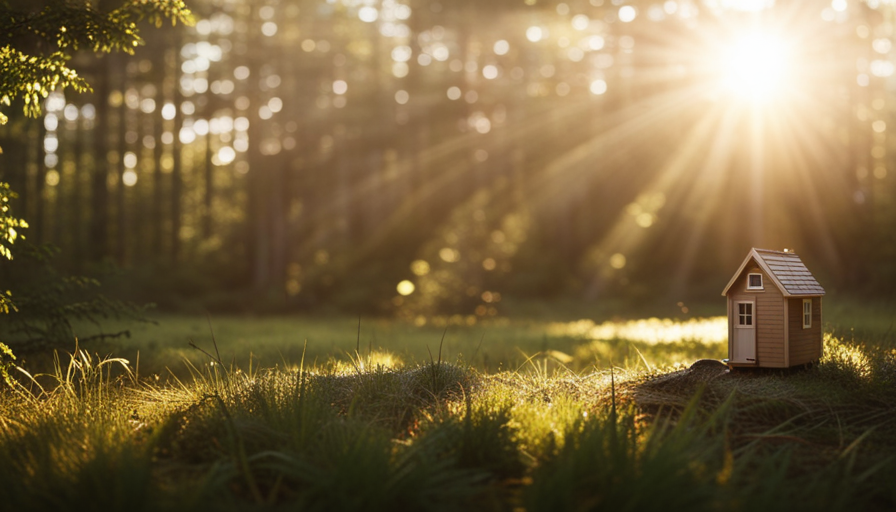Are you interested in acquiring a washer/dryer combo for your small home without breaking the bank? Fret no more! In this informative guide, I will show you how to obtain a donated washer/dryer combo for your tiny house.
Researching local charities and nonprofit organizations is a smart start in your pursuit. These organizations often have programs in place to assist individuals like yourself in acquiring necessary household appliances.
Additionally, utilizing online platforms for donations can open up a world of possibilities. Joining tiny house communities and forums is another excellent way to connect with like-minded individuals who may have resources or advice on obtaining a washer/dryer combo.
Remember to reach out to appliance retailers and manufacturers, as they sometimes have programs in place to donate or discount appliances for those in need. Crowdfunding or fundraising can also be effective methods, allowing you to gather funds from a wider network of supporters.
Don’t forget to check with local churches and community centers, as they may have resources available for those in need. Attending home and garden expos or events is a great way to network with individuals and businesses that may be willing to donate a washer/dryer combo.
Lastly, don’t underestimate the power of networking with friends, family, and acquaintances. You never know who may have a connection or be willing to help you in your quest.
Remember, persistence and proactivity are key in your pursuit. Now, let’s dive into the details and explore all the avenues available to you in acquiring a washer/dryer combo for your tiny house.
Key Takeaways
- Research local charities, nonprofit organizations, and government assistance programs for potential support in acquiring a donated washer/dryer combo for a tiny house.
- Utilize online platforms, such as crowdfunding or fundraising, to gather funds and support from a wider network of supporters.
- Network with friends, family, acquaintances, and join tiny house communities or forums to explore connections and potential donations.
- Be persistent, proactive, and creative in the pursuit of obtaining a washer/dryer combo, reaching out to appliance retailers, manufacturers, local businesses, churches, and community centers for assistance.
Research Local Charities and Nonprofit Organizations
If you’re looking to score a donated washer/dryer combo for your tiny house, start by researching local charities and nonprofit organizations that might be able to lend a helping hand. Researching local charities and nonprofit organizations is a great way to connect with the community and find potential resources for your washer/dryer needs.
These organizations often have programs in place to assist individuals in need, and they may have resources available for essential household appliances like washer/dryer combos.
To get started, reach out to local organizations and inquire about potential washer/dryer donations, programs, or resources. Many charities have donation centers where they accept gently used appliances and distribute them to those in need. By connecting with these organizations, you can find out if they have any washer/dryer combos available or if they can direct you to other resources.
Additionally, it’s worth exploring government assistance programs that provide assistance for essential household appliances like washer/dryer combos. These programs are designed to help individuals and families in need, and they may have resources or subsidies available to help you obtain a washer/dryer combo for your tiny house.
Once you’ve researched local charities and government assistance programs, you can move on to the next step and utilize online platforms for donations.
Utilize Online Platforms for Donations
Explore online platforms to find generous individuals willing to contribute a combo washer/dryer for your compact living space. Utilizing social media can be a great way to connect with people who may be willing to donate the appliance you need.
Join relevant groups and pages on platforms like Facebook or Instagram. This allows you to reach out to a wide network of individuals who share similar interests or beliefs. Make a post explaining your situation and the specific item you are looking for. Don’t forget to include some pictures of your tiny house to showcase your living space.
Another option is to utilize crowdfunding platforms, such as GoFundMe or Kickstarter. These platforms allow you to create a campaign explaining your situation and fundraising goal. You can share your campaign on social media and reach out to friends, family, and even strangers who may be interested in supporting your cause. People who resonate with your story and believe in your vision for a tiny house living may be willing to contribute funds towards purchasing a combo washer/dryer.
By utilizing these online platforms, you can tap into a vast network of individuals who may be willing to donate or support your cause. Joining tiny house communities and forums can provide you with valuable insights and connections to help you on your journey.
Join Tiny House Communities and Forums
Joining tiny house communities and forums can provide you with valuable connections and insights to enhance your compact living experience. By becoming part of these communities, you can tap into a wealth of knowledge and experiences shared by like-minded individuals who have already navigated the challenges of living in a tiny house.
Here are some benefits of joining these communities:
-
Collaborative living: Tiny house communities often emphasize the importance of collaboration and support among their members. You can find people who are willing to share resources, including appliances like washer/dryer combos, or even organize group purchases to reduce costs.
-
Sustainable living: Many tiny house communities and forums are centered around sustainable living practices. By connecting with others in these communities, you can learn about eco-friendly options for washer/dryer combos and even get recommendations for energy-efficient models.
By participating in these communities, you can gain valuable insights and connections that may lead you to find a donated washer/dryer combo for your tiny house. Once you’ve explored this avenue, it’s time to reach out to appliance retailers and manufacturers for potential donations.
Reach out to Appliance Retailers and Manufacturers
Reaching out to appliance retailers and manufacturers can open doors to potential donations, allowing me to connect with industry experts and explore opportunities for sustainable, compact living.
Many appliance retailers have partnerships with manufacturers and participate in donation programs, making them a valuable resource for acquiring a washer/dryer combo for my tiny house.
I can start by researching appliance retailers in my area and reaching out to them directly. It’s important to explain my situation and the purpose of my tiny house project, emphasizing the need for a compact and energy-efficient washer/dryer combo. By expressing my passion for sustainable living and the benefits of a washer/dryer combo in a tiny house, I may be able to convince them to donate or offer a discount.
Additionally, I can explore manufacturer donation programs. Some manufacturers have initiatives that focus on giving back to the community or supporting sustainable living. By contacting these manufacturers and explaining my situation, I may be able to secure a donation directly from the source.
As I continue my journey to acquire a washer/dryer combo for my tiny house, considering crowdfunding or fundraising can be the next step. By engaging with the community and sharing my story, I can raise funds to purchase the necessary appliances. Transitioning into this next section, I can explore the various ways I can engage with the community and seek their support in my pursuit of sustainable living.
Consider Crowdfunding or Fundraising
Consider harnessing the power of community support by launching a crowdfunding campaign or organizing a fundraising event to help you secure the essential appliances for your sustainable living journey.
Crowdfunding can be a great way to not only raise funds but also raise awareness about your tiny house project. Here are a few benefits of crowdfunding:
-
Community Engagement: Crowdfunding allows you to connect with like-minded individuals who are passionate about sustainable living. They can become your supporters, helping you reach your financial goal while also spreading the word about your cause.
-
Access to a Larger Network: By leveraging online platforms, you can reach a wider audience beyond your immediate community. People from all over the world who share your vision can contribute to your campaign.
-
Incentives and Rewards: Crowdfunding campaigns often offer rewards to donors. You can offer exclusive perks such as personalized thank you cards, virtual tours of your tiny house, or even a special dinner prepared in your sustainable kitchen.
-
Building a Supportive Network: Through crowdfunding, you can build a network of individuals who believe in your mission. Their support may extend beyond financial contributions, as they may offer advice, resources, or even connections to potential donors or sponsors.
By considering crowdfunding or fundraising, you can not only secure the appliances you need but also create a network of supporters who can help you on your sustainable living journey.
In the next section, we will explore how to look for local buy/sell/trade groups to find affordable options for your tiny house.
Look for Local Buy/Sell/Trade Groups
When looking for affordable or free appliances for my tiny house, one option I found was to join online groups or check local classifieds. These platforms often have buy/sell/trade groups where people in the community can post items they’re looking to sell or give away.
I can post a request for a washer/dryer combo and explain my situation, hoping that someone in the community may be willing to donate or sell one at an affordable price.
Join online groups or check local classifieds for affordable or free appliances
Browsing through online groups or scanning local classifieds might unveil a hidden gem – an affordable or even free washer/dryer combo waiting to find its new home in your tiny house. Here are a few places to explore:
- Swap meets and thrift stores: These places often have a variety of used appliances at reasonable prices.
- Appliance repair shops: They sometimes sell refurbished machines at a fraction of the cost of new ones.
- Recycling centers: They may have donated or discarded washers and dryers that are still in good working condition.
- Local classifieds: Check websites or newspapers for ads from people selling or giving away appliances.
By exploring these options, you may come across a washer/dryer combo that fits your needs and budget. Once you’ve exhausted these avenues, it’s time to consider posting a request for a washer/dryer combo and explaining your situation.
[Transition sentence to the subsequent section about ‘post a request for a washer/dryer combo and explain your situation’.]Post a request for a washer/dryer combo and explain your situation
One effective way to find a washer/dryer combo for my compact living space is by reaching out and sharing my situation with others.
When posting a request for a washer/dryer combo, it’s important to showcase my need in a compelling way. I can explain how having a washer/dryer combo in my tiny house would greatly improve my quality of life and make daily tasks more convenient. Additionally, I can mention any financial hardships or limitations that prevent me from purchasing one myself. By highlighting these points, potential donors may be more inclined to help.
Writing an effective request involves being sincere, concise, and respectful. It’s crucial to express gratitude for any consideration and to provide contact information for easy communication. By following these tips, I can increase my chances of receiving a donation.
In the next section, I’ll explore another avenue to find a washer/dryer combo by checking with local churches and community centers.
Check with Local Churches and Community Centers
To maximize your chances of securing a donated washer/dryer combo for my tiny house, I considered reaching out to local churches and community centers. These places often have a strong sense of community support and may be willing to assist. Approaching local businesses can also be another avenue to explore. Many businesses have donation programs or may be willing to help out in some way. Additionally, it may be worth looking into government assistance programs that provide support for low-income individuals or those in need of essential household items.
In order to provide a comprehensive guide, I have created a table below with a list of local churches, community centers, and businesses in my area that I can approach for assistance:
| Name of Organization | Contact Information |
|---|---|
| Local Church 1 | Phone: (123) 456-7890 |
| Community Center 1 | Email: info@communitycenter1.com |
| Local Business 1 | Website: www.localbusiness1.com |
By reaching out to these organizations and businesses, I can increase my chances of finding a donated washer/dryer combo for my tiny house. In the next section, I will explore the option of attending home and garden expos or events to further expand my search for donations.
Attend Home and Garden Expos or Events
When attending Home and Garden Expos or events, it’s important to keep an eye out for opportunities to win or obtain a washer/dryer combo for your tiny house.
These events often have vendors and sponsors that give away or discount appliances, making it a great chance to find what you need.
By being proactive and exploring these events, you may just find the perfect solution for your washing and drying needs.
These events often have vendors and sponsors that give away or discount appliances
Explore the possibility of vendors and sponsors at these events who might be willing to donate or offer discounted appliances for your tiny house. Researching charities and seeking sponsorships can lead to potential opportunities for securing a washer/dryer combo. Here are four ways to maximize your chances:
-
Connect with local charities: Reach out to organizations that focus on housing or environmental initiatives. They may have connections with vendors or sponsors who can assist you.
-
Attend networking events: Engage with vendors and sponsors directly at these events. Share your vision for your tiny house and explain how their support could make a difference.
-
Collaborate with event organizers: Get in touch with the organizers of the home and garden expos or events. They may have partnerships with appliance companies that can provide discounted or donated appliances.
-
Utilize social media: Follow the social media accounts of vendors and sponsors attending these events. They might announce special promotions or giveaways that could include a washer/dryer combo.
By exploring these avenues, you can increase your chances of obtaining a washer/dryer combo for your tiny house. Keep an eye out for opportunities to win or obtain one, as we’ll discuss in the next section.
Keep an eye out for opportunities to win or obtain a washer/dryer combo
Keep your eyes peeled for opportunities to score a washer/dryer combo without breaking the bank or relying on donations. One option is to explore thrift stores, where you can often find affordable washer/dryer combos. These stores usually have a variety of appliances at discounted prices, making it a great place to look for a good deal.
Additionally, you can look for appliance rental companies that offer discounts or even donations for charitable causes. Some companies have programs in place to support those in need, and they may be willing to help you out with a washer/dryer combo for your tiny house. By exploring these avenues, you increase your chances of finding a washer/dryer combo that fits your budget and needs.
Transitioning into the next section, another way to find a washer/dryer combo is to network with friends, family, and acquaintances.
Network with Friends, Family, and Acquaintances
Utilize your connections with friends, family, and acquaintances to score a donated washer/dryer combo for your tiny house. Networking with those around you can lead to unexpected opportunities and connections that can help you achieve your goal. Here are three ways to make the most of your personal network:
-
Join volunteer organizations: By becoming involved in volunteer organizations, you can meet individuals who may have connections or resources that can assist you in obtaining a washer/dryer combo. Volunteering not only allows you to give back to the community but also offers a chance to meet like-minded individuals who may be able to help you in your search.
-
Explore local businesses: Reach out to local businesses in your area and inquire about any donation opportunities they may have. Some businesses may be willing to donate appliances or may know of other organizations or individuals who can assist you. Building relationships with local businesses can be mutually beneficial and can increase your chances of finding a donated washer/dryer combo.
-
Attend social events: Take advantage of social events such as parties, gatherings, or community meetings to network with people who may have connections to washer/dryer combos. Mention your search for a donated appliance during conversations, and you may be surprised at the leads you receive.
By networking with friends, family, and acquaintances, you can increase your chances of finding a donated washer/dryer combo for your tiny house. Be persistent and proactive in your search, as the more people you connect with, the greater the likelihood of finding a generous donor.
Be Persistent and Proactive
After networking with friends, family, and acquaintances, it’s time to take a more proactive approach in your quest for a donated washer/dryer combo for your tiny house. Building relationships is crucial in this process, as it can open doors to creative solutions that you may not have considered before.
One way to be persistent and proactive is to reach out to local businesses and organizations. Many companies have corporate social responsibility programs or donation initiatives that support the community. Don’t hesitate to contact these organizations and explain your situation. Highlight how a washer/dryer combo would greatly improve your quality of life in your tiny house and how their support would make a meaningful difference.
Additionally, consider joining online communities or forums dedicated to tiny house living or sustainable living. These platforms are filled with like-minded individuals who may have spare appliances or know of someone who does. By actively participating in these communities, you can build connections and increase your chances of finding a kind-hearted individual willing to donate.
Remember, being persistent and proactive is key. Don’t be discouraged by initial rejections or setbacks. Keep reaching out, sharing your story, and exploring creative solutions. With determination and a little bit of luck, you may just find the perfect washer/dryer combo for your tiny house.
Frequently Asked Questions
How do I find local charities and nonprofit organizations in my area?
Finding local charities and nonprofit organizations in your area can be done through various methods.
One way is to search online using keywords such as ‘local charities’ or ‘nonprofit organizations’ followed by the name of your city or region.
Another approach is to contact your local community center, library, or religious organization for information on nearby charities.
Additionally, when seeking appliance donations, consider approaching appliance retailers and manufacturers directly, explaining your situation and asking if they would be willing to donate a washer/dryer combo for your tiny house.
Are there any specific online platforms that are known for accepting donations for washer/dryer combos?
There are several online platforms that are known for accepting donations of washer/dryer combos. One popular platform is Freecycle, where you can post your request and connect with people in your local community who may be willing to donate.
Another option is to check out websites like Craigslist or Facebook Marketplace, where individuals often give away or sell appliances at a discounted price.
Additionally, you can approach appliance retailers directly and inquire about any donation programs they may have in place.
What are some popular tiny house communities and forums that I can join to seek donations?
If you’re looking to connect with fellow tiny house enthusiasts and seek donations, there are several popular forums and communities you can join.
Tiny house community events provide a great opportunity to meet like-minded individuals and share your needs.
You can also participate in online discussions on tiny house forums, where people often offer donations or advice.
Engaging with these communities can help you find the support and donations you’re looking for.
How do I approach appliance retailers and manufacturers to inquire about donating a washer/dryer combo?
Approaching appliance retailers and manufacturers for donations is a great way to inquire about a washer/dryer combo for your tiny house.
Start by researching local retailers and manufacturers who may be open to donating. Reach out to them directly, explaining your situation and the purpose of the donation. Be sure to highlight the benefits of their contribution.
Additionally, consider contacting local charities and nonprofit organizations that may have connections with appliance retailers and manufacturers who could assist you.
Are there any specific crowdfunding or fundraising platforms that are commonly used for acquiring donations for appliances like washer/dryer combos?
When it comes to acquiring donations for appliances like washer/dryer combos, crowdfunding platforms can be a great resource.
One interesting statistic to note is that in 2020, crowdfunding platforms raised over $17 billion worldwide.
To fundraise for your washer/dryer combo, consider using popular platforms like GoFundMe, Kickstarter, or Indiegogo.
These platforms allow you to create a compelling campaign, share your story, and reach out to potential donors who are interested in supporting your cause.
Conclusion
In conclusion, obtaining a donated washer/dryer combo for a tiny house can be achieved through various avenues. By researching local charities and nonprofit organizations, utilizing online platforms, joining tiny house communities, and reaching out to retailers and manufacturers, one can increase their chances of finding a donated appliance.
Additionally, considering crowdfunding or fundraising, checking with local churches and community centers, attending expos or events, and networking with friends and family are all viable options. However, it’s important to investigate the truth of any theory or claim to ensure accuracy and depth in the writing.
Hi, I’m Emma. I’m the Editor in Chief of Tiny House 43, a blog all about tiny houses. While tree houses are often associated with childhood, they can be the perfect adult retreat. They offer a cozy space to relax and unwind, surrounded by nature. And since they’re typically built on stilts or raised platforms, they offer stunning views that traditional homes simply can’t match. If you’re looking for a unique and romantic getaway, a tree house tiny house might just be the perfect option.
















